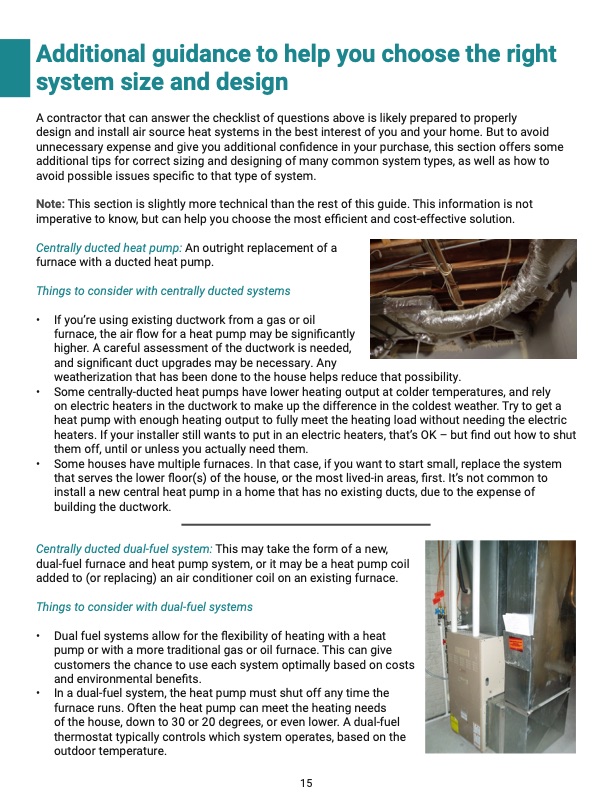
PDF Publication Title:
Text from PDF Page: 015
Additional guidance to help you choose the right system size and design A contractor that can answer the checklist of questions above is likely prepared to properly design and install air source heat systems in the best interest of you and your home. But to avoid unnecessary expense and give you additional confidence in your purchase, this section offers some additional tips for correct sizing and designing of many common system types, as well as how to avoid possible issues specific to that type of system. Note: This section is slightly more technical than the rest of this guide. This information is not imperative to know, but can help you choose the most efficient and cost-effective solution. Centrally ducted heat pump: An outright replacement of a furnace with a ducted heat pump. Things to consider with centrally ducted systems • If you’re using existing ductwork from a gas or oil furnace, the air flow for a heat pump may be significantly higher. A careful assessment of the ductwork is needed, and significant duct upgrades may be necessary. Any weatherization that has been done to the house helps reduce that possibility. • Some centrally-ducted heat pumps have lower heating output at colder temperatures, and rely on electric heaters in the ductwork to make up the difference in the coldest weather. Try to get a heat pump with enough heating output to fully meet the heating load without needing the electric heaters. If your installer still wants to put in an electric heaters, that’s OK – but find out how to shut them off, until or unless you actually need them. • Some houses have multiple furnaces. In that case, if you want to start small, replace the system that serves the lower floor(s) of the house, or the most lived-in areas, first. It’s not common to install a new central heat pump in a home that has no existing ducts, due to the expense of building the ductwork. Centrally ducted dual-fuel system: This may take the form of a new, dual-fuel furnace and heat pump system, or it may be a heat pump coil added to (or replacing) an air conditioner coil on an existing furnace. Things to consider with dual-fuel systems • Dual fuel systems allow for the flexibility of heating with a heat pump or with a more traditional gas or oil furnace. This can give customers the chance to use each system optimally based on costs and environmental benefits. • In a dual-fuel system, the heat pump must shut off any time the furnace runs. Often the heat pump can meet the heating needs of the house, down to 30 or 20 degrees, or even lower. A dual-fuel thermostat typically controls which system operates, based on the outdoor temperature. 15PDF Image | Air Source Heat Pump Buying Guide

PDF Search Title:
Air Source Heat Pump Buying GuideOriginal File Name Searched:
ASHP_buyingguide_5.pdfDIY PDF Search: Google It | Yahoo | Bing
CO2 Organic Rankine Cycle Experimenter Platform The supercritical CO2 phase change system is both a heat pump and organic rankine cycle which can be used for those purposes and as a supercritical extractor for advanced subcritical and supercritical extraction technology. Uses include producing nanoparticles, precious metal CO2 extraction, lithium battery recycling, and other applications... More Info
Heat Pumps CO2 ORC Heat Pump System Platform More Info
| CONTACT TEL: 608-238-6001 Email: greg@infinityturbine.com | RSS | AMP |